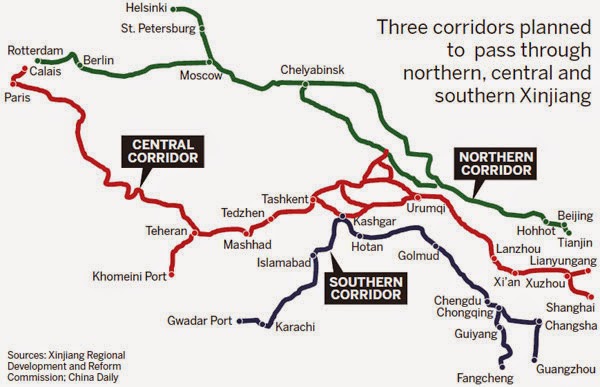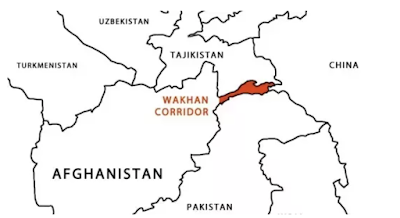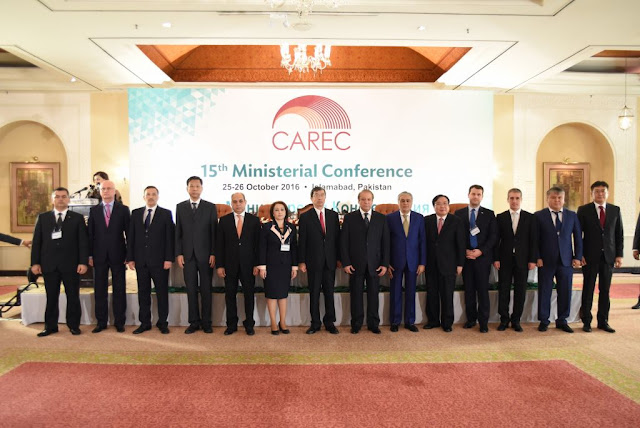PakAlumni Worldwide: The Global Social Network
Uzbekistan is the third landlocked state in recent years to request the use of Pakistani ports for trade, according to media reports. The Central Asian nation has asked to join Quadrilateral Traffic in Transit Agreement (QTTA) to make use of Karachi and Gwadar ports for its trade operations. Current members of QTTA are China, Pakistan, Kyrgyzstan and Kazakhstan. Afghanistan is not a member of QTTA but it currently uses Gwadar and Karachi ports under Afghanistan-Pakistan Transit Trade Agreement (APTTA). Pakistan is making a serious effort to stabilize Afghanistan, a member of CAREC. The recent US-Taliban peace deal is the result of Pakistan's efforts to bring the warring sides to the negotiating table. Afghan instability has prevented Pakistan from connecting with other STANs for commerce and trade. Now the development of CPEC will enable Pakistan to bypass Afghanistan, if necessary, to connect with Central Asia region through Western China.
Pakistan to Bypass Afghan Wakhan Corridor to Trade With Central Asia Via China |
Quadrilateral Traffic in Transit Agreement (QTTA):
The Quadrilateral Traffic in Transit Agreement (QTTA) is a transit trade deal between China, Pakistan, Kyrgyzstan and Kazakhstan for facilitating transit traffic and trade.
In addition to being members of QTTA, China, Pakistan, Kyrgyzstan and Kazakhstan are also part of CAREC, the Central Asian Regional Economic Cooperation. Other CAREC member nations include Afghanistan, Azerbaijan, Georgia, Mongolia, Tajikistan , Turkmenistan and Uzbekistan.
China-Pakistan Economic Corridor (CPEC) infrastructure projects have strengthened Pakistan's connectivity with landlocked Central Asia region in recent years.
CAREC Ministerial Meeting Islamabad, Pakistan |
CAREC or SAARC:
Pakistan sits between two economically very dynamic regions: Central Asia (and Western China) and South Asia. Which region is better suited for its economic connectivity and integration? Should Islamabad focus on CAREC (Central Asia Regional Economic Cooperation) rather than SAARC (South Asian Association of Regional Cooperation)?
Ideally, Pakistan should be a major player in both vibrant regions. However, Indian Prime Minister Narendra Modi has adopted a belligerent tone that has been characterized by his boasts of "chhappan inch ki chhati" (56 inch chest) and talk of "munh tor jawab" (jaw-breaking response) and "boli nahin goli" (bullets, not talks) to intimidate Pakistan in the last few years. All of Modi's actions, including his order to bomb Balakot in Pakistan in February 2019, have signaled his outright aggression against Pakistan. His government's actions in Kashmir have extinguished any hope of normal relations between South Asia's two largest economies in the foreseeable future. These have essentially forced Pakistan to choose between SAARC and CAREC.
CAREC Corridors:
CAREC region is building six economic corridors to link Central Asian nations. Six multi-national institutions support the CAREC infrastructure development, including the Asian Development Bank (ADB), United Nations Development Program (UNDP), International Monetary Fund (IMF), World Bank, Jeddah-based Islamic Development Bank and European Bank for Reconstruction & Development, according to Khaleej Times.
Out of the total $27.7 billion CAREC infrastructure investment so for, $9.9 billion or 36 per cent was financed by ADB, a senior officer of the Manila-based multinational bank told Khaleeej Times.
He said other donors had invested $10.9 billion while $6.9 billion was contributed by CAREC governments. Of these investments, transport got the major share with $8 billion or 78 per cent. Asian Development Bank Vice President Wencai Zhang said: "There are huge financing requirements in Carec for transport and trade facilitation, for which 108 projects have been identified at an investment cost of $38.8 billion for the period 2012-2020. Investment for the priority energy sector projects will be $45 billion in this period."
CPEC North-South Corridor:
China Pakistan Economic Corridor (CPEC) is a major part of the north-south corridor that will allow trade to flow among CAREC member countries, many of which are resource-rich but landlocked nations. The corridor will enable the group to access to the Pakistani seaports in Gwadar and Karachi as part of the new maritime silk route (MSR) as envisioned by China and Pakistan.
CPEC consists of transport and communication infrastructure—roads, railways, cable, and oil and gas pipelines—that will stretch 2,700 kilometers from Gwadar on the Arabian Sea to the Khunjerab Pass at the China-Pakistan border in the Karakorams.
China and Pakistan are developing plans for an 1,800 kilometer international rail link from the city of Kashgar in the Xinjiang Uygur autonomous region in Western China to Pakistan's deep-sea Gwadar Port on the Arabian Sea, according to Zhang Chunlin, director of Xinjiang's regional development and reform commission.
 |
| Rail Network Bypasses Afghanistan |
"The 1,800-kilometer China-Pakistan railway is planned to also pass through Pakistan's capital of Islamabad and Karachi," Zhang Chunlin said at the two-day International Seminar on the Silk Road Economic Belt in Urumqi, Xinjiang's capital, according to China Daily.
"Although the cost of constructing the railway is expected to be high due to the hostile environment and complicated geographic conditions, the study of the project has already started," Zhang said. "China and Pakistan will co-fund the railway construction. Building oil and gas pipelines between Gwadar Port and China is also on the agenda," Zhang added.
Afghan Instability:
Pakistan is making a serious effort to stabilize Afghanistan, a member of CAREC. The recent US-Taliban peace deal is the result of Pakistan's efforts to bring the warring sides to the negotiating table. Afghan instability has prevented Pakistan from connecting with other STANs for commerce and trade. Now the development of CPEC will enable Pakistan to bypass Afghanistan, if necessary, to connect with Central Asia region through Western China.
Summary:
A growing list of landlocked Central Asian countries is lining up to use Pakistani ports of Gwadar and Karachi for trade. Uzbekistan is the latest nation to do so. China-Pakistan Economic Corridor (CPEC) infrastructure projects have strengthened Pakistan's connectivity with landlocked Central Asia region in recent years. The Quadrilateral Traffic in Transit Agreement (QTTA) is a transit trade deal between China, Pakistan, Kyrgyzstan and Kazakhstan for facilitating transit traffic and trade.
In addition to being members of QTTA, China, Pakistan, Kyrgyzstan and Kazakhstan are also part of CAREC, the Central Asian Regional Economic Cooperation. Other CAREC member nations include Afghanistan, Azerbaijan, Georgia, Mongolia, Tajikistan, Turkmenistan and Uzbekistan. Pakistan is making a serious effort to stabilize Afghanistan, a member of CAREC. The recent US-Taliban peace deal is the result of Pakistan's efforts to bring the warring sides to the negotiating table. Afghan instability has prevented Pakistan from connecting with other STANs for commerce and trade. Now the development of CPEC will enable Pakistan to bypass Afghanistan, if necessary, to connect with Central Asia region through Western China.
Related Links:
Central Asia Regional Economic Cooperation (CAREC)
Modi's India: A Paper Elephant?
China Pakistan Economic Corridor
CPEC to Create Over 2 Million Jobs
ADB Raises Pakistan GDP Growth Forecast
China-Pakistan Industrial Corridor
Indian Spy Kulbhushan Yadav's Confession


Riaz Haq
#Chinese Gov't Commissioned Study: #China-#Pakistan #railway ‘worth it’ at estimated US$58 billion. It should proceed because of its #strategic significance. It has the potential to reshape #trade and #geopolitics across the Eurasian continent. #CPEC https://www.scmp.com/news/china/science/article/3218413/china-pakis...
Belt and Road Initiative’s most expensive transport infrastructure project ‘has potential’ to reshape trade and geopolitics
The rail link is part of a broader plan to revive ancient Silk Road connections and reduce reliance on Western-dominated routes
The China-Pakistan railway – China’s largest Belt and Road Initiative transport project – will cost an estimated 400 billion yuan (US$57.7 billion), but should proceed because of its strategic significance, a government-commissioned feasibility study has found.
The proposed railway, connecting Pakistan’s port of Gwadar to Kashgar in China’s Xinjiang Uygur autonomous region, was assessed by scientists from the state-owned China Railway First Survey and Design Institute Group Co Ltd.
The team, led by the institute’s deputy director of capital operations Zhang Ling, said the project was the belt and road plan’s most expensive transport infrastructure.
Despite the cost, the project had the potential to reshape trade and geopolitics across the Eurasian continent and should be supported, the team said in a report published by the Chinese-language journal Railway Transport and Economy in April.
“The government and financial institutions [in China] should provide strong support, increase coordination and collaboration among relevant domestic departments, strive for the injection of support funds and provide strong policy support and guarantees for the construction of this project,” they said.
The institute is one of the largest of its kind in China and has been involved in many major railway projects at home and internationally, including Indonesia’s Jakarta-Bandung high-speed rail line.
The 3,000km (1,860-mile) railway will link China’s western regions with the Arabian Sea, bypassing the Strait of Malacca and reducing dependence on the South China Sea.
Connections with other transport networks – including in Iran and Turkey – would also provide a more direct route to Europe for Chinese goods, while Pakistan is forecast to get a much-needed boost from the improved infrastructure and easier trade with China.
The scheme is a key component of Beijing’s broader belt and road plan to promote economic cooperation and connectivity among the countries along the ancient Silk Road trade routes.
Previous studies by Chinese government researchers have suggested the infrastructure initiative could have significant geopolitical implications, helping to shift the balance of power away from traditional Western-dominated trade routes.
As well as encouraging a more multipolar world order, the belt and road plan could also help to promote economic development and stability in countries along the route by creating jobs, boosting infrastructure investment and increasing trade, the studies said.
Most belt and road transport infrastructure construction projects had received a significant proportion of funding from the host countries, and the scale of investment was much smaller, Zhang and his colleagues noted.
For example, total investment in Kenya’s Mombasa-Nairobi standard gauge railway was US$3.8 billion, with China providing 5 per cent of the funding and Kenya paying for the rest.
Apr 27, 2023
Riaz Haq
#Chinese Gov't Commissioned Study: #China-#Pakistan #railway ‘worth it’ at estimated US$58 billion. It should proceed because of its #strategic significance. It has the potential to reshape #trade and #geopolitics across the Eurasian continent. #CPEC https://www.scmp.com/news/china/science/article/3218413/china-pakis...
The project connects the port city to the Kenyan capital and is part of a larger plan to link East African countries by rail. Similarly, China contributed 30 per cent of the US$4 billion funding for the Addis Ababa-Djibouti rail line in Ethiopia.
China covered 75 per cent of the Jakarta-Bandung high-speed railway’s costs of US$5.9 billion, with Indonesian state-owned enterprises providing the remainder.
But Pakistan is unable to make a similar contribution. Its GDP last year was US$370 billion – just six times the estimated cost of the project.
“Due to energy shortages, poor investment environment and fiscal deficits,
Pakistan’s economic growth rate has come under pressure,” the team said.
“In terms of railway investment and construction, Pakistan is unable to provide sufficient financial and material support and mainly relies on Chinese enterprises for investment and construction.”
One reason for the hefty cost is the mountainous and geologically complex terrain along the route. There could be technical challenges to overcome in the construction and operation of the railway, the researchers said.
The project also required supporting infrastructure – such as ports and logistics facilities – that might not be immediately available in Pakistan, they said.
The study said Pakistan’s labour policies could be unpredictable, which could potentially affect the railway’s construction and operating costs.
The team also noted that Pakistan had experienced security challenges in recent years, including in its western region where the railway will pass through. Balochistan province, for instance, has been plagued by separatist violence for decades.
This could potentially disrupt construction and operation of the railway and pose a risk to Chinese workers and investments, the researchers said.
The study also pointed out the railway’s potential impact on neighbouring countries, such as India. With each country having its own priorities and interests, there could be disagreements or delays in decision-making related to the project, it said.
Zhang’s team suggested that a build and transfer (BT) model would provide the best investment and financing strategy for the project.
They considered BT against build-operate-transfer, public-private partnerships, and the engineering, procurement, construction mode that are becoming more popular in belt and road projects.
In the BT model, a contractor would be responsible for designing, building and financing the railway, with payment on completion and ownership transferred to the government or other commissioning entity.
The researchers said BT would allow the risks associated with the railway’s construction and operation to be allocated more effectively between China and Pakistan, potentially reducing the financial risks for both parties.
By ensuring that ownership of the railway was transferred to Pakistan, BT could also help to build trust between China and Pakistan by showing China’s commitment to supporting Pakistan’s long-term economic development, they said.
China and Pakistan have been talking for years about the railway, a crucial part of the China-Pakistan Economic Corridor (CPEC) that was launched in 2015 and aims to connect Gwadar port to Xinjiang through a network of roads, railways and pipelines.
The researchers said the China-Pakistan relationship was complex, with both countries having different priorities and interests.
Negotiating agreements related to financing, labour policies, and other issues would require careful consideration of each country’s priorities and interests, they said.
In conclusion, Zhang and his team said their recommendation could help to move negotiations forward.
Apr 27, 2023
Riaz Haq
EIU (Economic Intelligence Unit)report
China Going Global Investment Index 2023
This year’s edition of the China Going Global Investment Index ranks 80 economies across nearly 200 indicators to identify opportunities and risk for Chinese firms and investors looking to expand globally.
A decade since Xi Jinping’s Belt and Road Initiative (BRI) launched in 2013, Chinese firms have become formidable investors globally, and the flow of overseas investment is set to increase over the next decade.
Sep 7, 2023